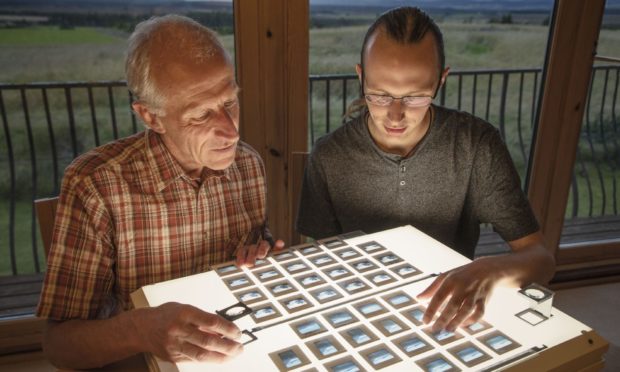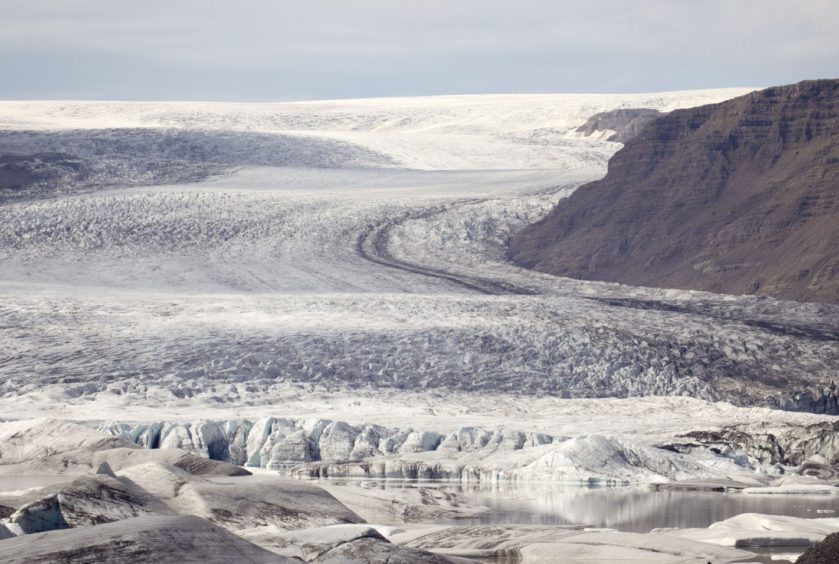A Dundee University researcher has followed his famous father’s footsteps across the glaciers of Iceland to chart a generation of dramatic change.
More than three decades on, Dr Kieran Baxter has replicated images taken by his father, celebrated Scottish landscape photographer Colin Baxter to demonstrate the devastating effects of climate change.
The pair worked together to replicate original images, taken by Colin on a family holiday in 1989, to show the retreat of several outlet glaciers of the Vatnajökull ice cap – Fláajökull, Heinabergsjökull, Hoffellsjokull, Hólarjökull and Skaftafellsjökull – in the south east of the country.
Following in father’s footsteps
“While our work is quite different in some ways, here you can say I am quite literally following in my dad’s footsteps,” said Kieran, a lecturer in communication design at the University’s Duncan of Jordanstone College of Art & Design.
“It is personally devastating to see them change so drastically in the last few decades in a way that is not immediately obvious from a single visit.
Communication design lecturer Kieran Baxter
“I grew up visiting these amazing places and inherited an understanding of the quiet power of these landscapes.
“It is personally devastating to see them change so drastically in the last few decades in a way that is not immediately obvious from a single visit.”
He added: “On surface appearances the extent of the climate crisis often remains largely invisible, but here we can clearly see the gravity of the situation that is affecting the entire globe.”
Dr Baxter has established himself as a leading expert in the visual communication of glacial retreat across Europe.
As well as documenting how a century of global warming has caused vast levels of ice loss around Mont Blanc, he has also published dramatic aerial photographs showing the disappearance of some of Iceland’s largest glaciers, working in conjunction the University of Iceland and the National Land Survey of Iceland.
Huge decrease in area of Iceland’s largest glacier
In the three decades that have elapsed since 1989, Vatnajökull ice cap, the largest glacier Europe, has lost 150–200 km³ of ice and its area has shrunk by 400 km² according to the Icelandic Meteorological Office.
Many glacier termini have retreated by more than a kilometre in the period.
Keiran added: “To replicate the photographs we have to locate features in the foreground and background and then use trial and error to find the right location on the ground.
“It can take some time to correctly align the old and new photographs but in the end we can usually find the camera position to within a few metres of the original location.
“I was too young to remember the 1989 trip, but I can picture our later visits to Iceland as a family in the 1990s.”
Bittersweet experience
“It is a bittersweet experience to relive those memories and witness the glacial landscapes that we visited that have now changed so radically,” said Colin.
“Revisiting my pictures of Iceland in 1989 of course brought back many good memories of being there for the first time with our very young children.
“I remember being in absolute awe of the stunning natural landscape and overwhelmed by the beauty of the glaciers tumbling down from the icecap up there in the distance.
“Now in 2020, it is equally overwhelming, and extremely alarming, to see the disappearance of all that ice after only 30 years.
“I just hope that we can wake up to the real dangers that lie ahead with the continued degradation of our environment, not just in Iceland but around the world.
Colin Baxter
“We all have to take responsibility for that, myself included.
“Our activity has indisputably contributed to the colossal volume of the melt which carries on today.
“I just hope that we can wake up to the real dangers that lie ahead with the continued degradation of our environment, not just in Iceland but around the world, and accelerate our efforts to reduce our greenhouse gas emissions and other environmental impacts.
“We certainly owe that to the families of the future.
“I hope they can continue to enjoy these inspirational landscapes as we have done in previous decades,” said Colin.











